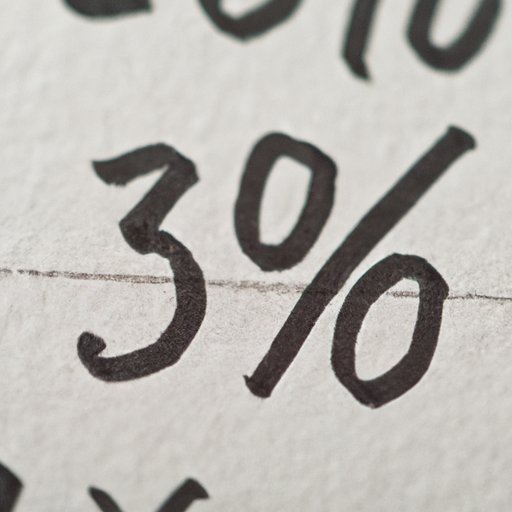
Introduction
Calculating percentages is an essential part of our everyday lives, from shopping to finance to cooking. It is a crucial skill to master, as it helps us understand and make informed decisions based on data. Hence, this article will provide a step-by-step guide on how to calculate percentages, with practical examples, infographics, practice problems, shortcuts, and real-world applications.
Step-by-Step Instructions
To begin with, let’s define what a percentage is and how it relates to fractions and decimals. A percentage is a representation of a part of a whole expressed as a fraction of 100. For example, if you want to express 25% of 200, you can convert it to a fraction 25/100 or a decimal of 0.25.
The formula for calculating a percentage can be expressed as follows:
Percentage = (part / whole) x 100
Here, the “part” refers to the number we want to find the percentage of, while the “whole” refers to the total amount. Now to calculate, let’s follow these steps:
Example: Find 20% of 150.
Step 1: Write the percentage as a fraction or decimal
20% = 20/100 or 0.2
Step 2: Multiply the percentage by the whole number
0.2 x 150 = 30
Therefore, 20% of 150 equals 30.
It is essential to remember to convert the decimal or fraction to a percentage for some applications. You can do this by multiplying the decimal or fraction by 100.
Real-World Examples
Understanding percentages is crucial in everyday life. Let’s consider real-world examples to help illustrate how different businesses, banks, and services incorporate percentages into their practices.
Consider mortgages, which are a common way many people use to buy homes. It involves borrowing a particular sum of money from a lender, and then over time, making payments to the lender with interest. The interest or percentage accrued depends on the loan’s total amount and the chosen repayment period.
Another example is the stock market, where investors use percentages to evaluate price fluctuations. For instance, if a stock’s price rises by 10%, investors can estimate the stock’s new and higher price.
Infographics
Infographics are a useful tool for visually breaking down percentage calculations into easy-to-understand steps. Let’s take an example of how to calculate a 25% tip on a $60 restaurant bill.
In the example above, the infographic visually represents the bill amount, and then uses colors to highlight crucial steps in the calculation. We recommend using a similar approach when making your infographics.
Practice Problems
We learn better when we put theoretical concepts into practical use. Hence, providing practice problems of various difficulty levels will help you refine your percentage calculation skills.
Example: What percentage of 200 is 25?
Solution:
Step 1: Calculate the percentage value as follows:
(25/200) x 100 = 12.5%
Thus, 25 is 12.5% of 200.
Comparison to Fractions and Decimals
Percentages can be represented in fractions and decimals formats, making it essential to understand how they relate to each other.
Example: Convert 60% to decimal and fraction form.
Solution:
To convert 60% to a decimal, we divide by 100:
60/100 = 0.6
Hence, 60% expressed as a decimal is 0.6.
To convert 60% to a fraction, we consider it as a fraction and simplify to its lowest form:
60% can be expressed as a fraction 60/100 or 3/5 in its simplest form.
This concept applies to various real-world applications, such as calculating tip percentages in restaurants.
Shortcuts
There are different ways to make percentage calculations faster and easier. Here are some shortcuts:
Shortcut 1: Half the percentage value to find 10%
For instance, to find 20% of 200, find 10% first by dividing by 2, i.e., 20/2 = 10, then use this figure to calculate 20%. Therefore, 20% of 200 equals 40.
Shortcut 2: Use the rule of 100 for percentage equivalents
For example, 10% is equal to 0.1 or 10/100. Similarly, 25% is equal to 0.25 or 25/100.
Real-World Applications
Percentage calculations are widely used in different fields and professions. For instance:
– In finance, percentages are used in calculating interest rates, inflation rates, and investment returns.
– Manufacturers use percentages to compare costs and pricing strategies.
– Marketers use percentages to measure the success of advertising campaigns and sales.
Understanding percentages is essential in these fields and many others.
Conclusion
Calculating percentages is relevant to our daily lives, and with this guide, you can now refine your percentage calculation skills. We’ve covered everything from defining percentages, step-by-step instructions, infographics, practice problems, shortcuts, and real-world applications. Remember to practice what you’ve learned, and over time, you’ll be able to apply these skills to different scenarios in your daily life.





